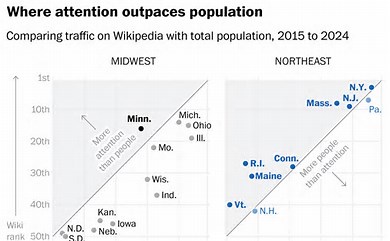
States in the Spotlight: Overlooked and Undervalued
Table of Contents
In the vast expanse of the United States, certain states capture national attention with regularity due to their economic power, political influence, or sheer size. However, the national spotlight often leaves other in the shadows, with their unique qualities and contributions going unnoticed. This dynamic can lead to perceptions of some states as “overexposed” while others are “underappreciated” or “forgotten.” Understanding this distribution of attention sheds light on the complexities of American regionalism and the diverse landscape of the nation.
The States That Get Too Much Attention
- California
As the most populous state in the U.S. and a significant economic powerhouse, California often finds itself in the national spotlight. The influence extends across various domains, including technology, entertainment, and agriculture. Silicon Valley is a global tech hub, Hollywood is synonymous with the film industry, and the state’s agricultural output is a cornerstone of the national food supply. However, this intense focus can overshadow other regions and create a skewed perception of the state’s challenges and nuances. - New York
New York’s prominence, particularly New York City’s, often overshadows the rest of the state. The city is a major financial center, cultural epicenter, and a key player in global media. While the city’s vibrancy and significance are undeniable, the rest of New York State, with its rural areas, historical sites, and natural beauty, sometimes receives less attention. The diverse landscape and local issues can get lost amid the focus on the metropolis. - Texas
Texas, with its massive size and economic might, frequently grabs national headlines. The state’s energy sector, cultural identity, and political influence make it a focal point in national discourse. Its size and economic output can lead to an overwhelming amount of attention, potentially overshadowing the unique characteristics and challenges of other states. - Florida
Known for its tourism industry, vibrant culture, and significant electoral votes, Florida is often in the news. Its tropical weather and political battleground status contribute to its frequent appearances in national media. However, the focus on its high-profile cities and election dynamics can sometimes obscure the diverse local issues and environmental concerns. - Illinois
Chicago, as one of the largest and most influential cities in the U.S., draws substantial attention. The city’s economic and cultural significance means that Illinois often gets a lot of national focus. However, the rural areas, economic challenges outside the city, and diverse regions can be overlooked.
The States That Are Truly Forgotten
- Wyoming
Wyoming is one of the least populous states, and its vast, open spaces are often overshadowed by more densely populated regions. Despite its natural beauty, including Yellowstone National Park and Grand Teton National Park, Wyoming doesn’t receive much national media attention. Its small population and significant rural character contribute to its lower profile. - Vermont
Vermont is known for its picturesque landscapes, quaint towns, and progressive policies. However, its small size and population mean it often gets less national attention. Vermont’s local issues, unique culture, and historical significance can sometimes be overshadowed by larger with more substantial media presence. - Maine
Maine, with its rugged coastline and maritime heritage, is frequently overlooked in national conversations. Its relatively small population and geographical location can make it seem less relevant compared to more populous states. However, Maine’s distinctive culture, economic challenges, and natural beauty make it a state worthy of more attention. - Montana
Montana’s vast landscapes and sparse population contribute to its lower profile on the national stage. Known for its national parks and outdoor recreational opportunities, Montana is often overshadowed by more populous states. Its local issues and economic conditions can go unnoticed amid the focus on larger. - New Hampshire
New Hampshire, despite its historical significance and role in the presidential primary process, often flies under the radar in national discussions. Its small size and population mean it doesn’t attract as much media attention, and its local issues can be overlooked compared to larger with more substantial media presence.
The Dynamics of Attention
The disparity in attention between states often reflects a combination of factors, including population size, economic power, media influence, and political significance. States with large populations, significant economic contributions, or high-profile cities tend to attract more media coverage and national focus. Conversely, states with smaller populations or less economic clout can find themselves in relative obscurity.
This uneven distribution of attention can have various implications. For states that receive too much focus, there can be an oversimplification of their complexities, with national narratives often driven by a few high-profile issues or personalities. This can lead to a skewed understanding of the state’s challenges and contributions.
For states that are overlooked, the lack of national attention can result in fewer resources, reduced visibility for local issues, and a diminished sense of national recognition. These states might struggle to attract investment or address unique regional challenges without the same level of support or awareness that more prominent states enjoy.
Bridging the Gap
Addressing the imbalance in attention requires a broader appreciation of the diverse contributions and challenges of all states. By highlighting the unique characteristics, local issues, and cultural contributions of states that are often overlooked, there can be a more nuanced understanding of the nation as a whole.
Media coverage and public discourse can play a crucial role in balancing this attention. By showcasing the stories and achievements of less prominent states, the national conversation can become more inclusive and representative of the country’s diverse landscape.
In addition, fostering a greater awareness of the contributions and challenges of all states can lead to more equitable resource distribution and policy attention. Recognizing the value of each state’s unique attributes and addressing their specific needs can help build a more balanced and comprehensive national perspective.







